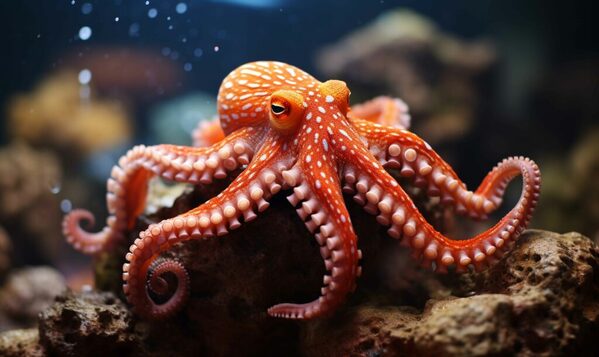The octopus is one of the ocean's most fascinating creatures, known for its intelligence, unique anatomy, and remarkable abilities like camouflage and squeezing through tiny spaces. But one of its most extraordinary features is having three hearts. Let’s dive deeper into the biology behind this incredible adaptation, explore how it benefits the octopus, and compare it to other animals with unusual circulatory systems.

The aquatic lifestyle of octopuses demands a highly efficient circulatory system. Living in water, especially in cold or oxygen-depleted environments, means oxygen availability can be limited. To meet this challenge, evolution provided the octopus with three hearts, ensuring its body gets enough oxygen to survive and thrive.
Efficient Oxygen Transport
Unlike humans, who rely on a single heart to pump oxygen-rich blood, octopuses have a specialized system. Their three hearts distribute blood precisely to the gills and the body, maximizing oxygen intake and delivery.
Adaptation to Deep Sea Living
Many octopus species live in the deep sea, where oxygen levels are lower. Having multiple hearts ensures their muscles and organs function properly, even in such challenging conditions.
Each of the three hearts has a specific role:
Two Branchial Hearts
Located near the gills, these hearts pump blood to the gills, where it gets oxygenated.
They operate as a localized oxygen-supplying system, ensuring continuous blood flow to and from the gills.
One Systemic Heart
This heart pumps the oxygen-rich blood from the gills to the rest of the body.
It’s the main driver of the octopus’s overall circulatory system.
Unique Feature: When the octopus swims, the systemic heart temporarily stops beating. This quirk is why octopuses often prefer crawling over swimming—swimming exerts extra pressure on their circulatory system, making it less efficient.
In addition to having three hearts, octopuses also have blue blood. This distinctive feature arises from hemocyanin, a copper-based molecule that carries oxygen in their blood.
Why Blue?
Hemocyanin binds with oxygen and gives the blood a blue color, unlike the red blood of humans, which relies on iron-based hemoglobin.
Advantages of Hemocyanin
More effective in cold, low-oxygen environments.
Supports the octopus's active lifestyle and high metabolic needs in deep-sea habitats.
This combination of three hearts and blue blood ensures octopuses are perfectly adapted to their aquatic environments.
The circulatory system of the octopus is one of its most critical survival tools. Here’s how it benefits them:
Efficient Energy Distribution
Their three-heart system supports their high-energy behaviors like hunting, crawling, and escaping predators.
Adaptation to Environmental Stress
Octopuses can regulate oxygen delivery based on their activity level. For example, when resting, they conserve energy by reducing their oxygen requirements.
Support for Complex Behavior
Their brains are highly developed, and the circulatory system ensures sufficient oxygen supply to support their intelligence and problem-solving skills.
The three-heart system is just one of the many extraordinary traits that make octopuses unique. Here are some others:
Incredible Intelligence
Octopuses are some of the smartest invertebrates, capable of solving puzzles, escaping enclosures, and even using tools.
Master of Disguise
Using specialized skin cells called chromatophores, octopuses can change color and texture to blend seamlessly with their surroundings.
Escape Artists
With no bones, octopuses can squeeze through spaces much smaller than their bodies, making them elusive and difficult to capture.
Ink Defense Mechanism
When threatened, octopuses release a cloud of ink to confuse predators and make a quick getaway.
Octopuses aren’t the only creatures with multiple hearts. Here are some others:
Squids and Cuttlefish
These cephalopod relatives also have three hearts and blue blood, as they share similar evolutionary adaptations.
Earthworms
While not technically “hearts,” earthworms have multiple aortic arches (pseudo-hearts) that pump blood through their segmented bodies.
Hagfish
These primitive aquarium/52-marine-animals.html">marine animals have four hearts, helping them survive in the deep ocean.
While having three hearts doesn’t directly make octopuses smarter, their efficient oxygen distribution supports their highly developed brains. Octopuses have:
500 million neurons, most of which are distributed in their arms.
The ability to independently control their arms for tasks like opening jars or exploring their surroundings.
Short lifespans, yet they achieve remarkable feats of intelligence within their limited time.
1. What happens if an octopus loses a heart?
Losing the systemic heart would likely be fatal since it supplies blood to the entire body. However, damage to a branchial heart might limit oxygen intake temporarily but wouldn’t necessarily kill the octopus immediately.
2. Why do octopuses stop their systemic heart when swimming?
Swimming requires more oxygen, but it’s less efficient for an octopus’s circulatory system. The systemic heart pauses to prevent overexertion, forcing the octopus to rely on its branchial hearts for oxygen supply.
3. How does the octopus's circulatory system compare to humans?
While humans rely on a single heart and hemoglobin for oxygen transport, octopuses have a more complex system suited for underwater living, including three hearts and hemocyanin-based blood.
The octopus’s three hearts, blue blood, and other remarkable adaptations highlight nature’s ingenuity. These features are not just fascinating trivia—they’re essential for survival in the challenging environments of the ocean. Whether you’re marveling at their intelligence, admiring their camouflage skills, or learning about their anatomy, octopuses prove time and again that they’re among the most extraordinary creatures on Earth.
Next time you encounter an octopus in the wild or at an aquarium, take a moment to appreciate the biological masterpiece it represents—a creature with three hearts, a brain in every tentacle, and an endless ability to amaze.
animal tags: octopus
We created this article in conjunction with AI technology, then made sure it was fact-checked and edited by a Animals Top editor.